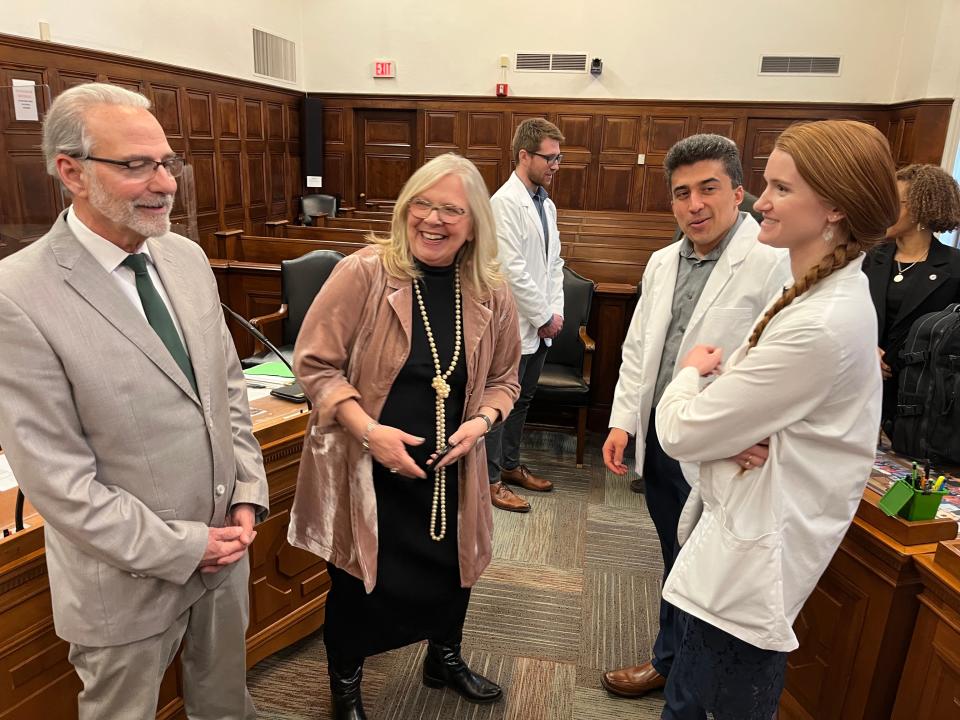What to know about Akron's 2023 budget: taxes, contracts, overtime and medical debt relief
Akron's 2023 operating budget, approved Monday by a vote of 9-4 ahead of the March 31 state deadline, is propped up by one-time federal COVID relief funds and weighed down by labor costs that will continue to climb for the foreseeable future.
It also maintains language that allows the mayor and his Cabinet, for the time being, to continue a 56-year practice of hiring consultants without getting prior approval from Akron City Council. Mayor Dan Horrigan said he's open to changing the provision, called Section 56, and won't use it to sign new contracts without council approval until reaching a deal.
The new operating budget earmarks almost all that is left of the $145 million Akron received from the American Rescue Plan Act (ARPA). Most this year will be spent on rebuilding community centers in West Akron and North Hill, new pools in Sherbondy Hill and Goodyear Heights, upgrades to Lock 3 and Summit Lake, and grant programs to repair homes and reduce violence.
Beyond these specific projects, here are six items to consider in Akron's current and future budgets.
Sewer project still driving debt
The city is still borrowing heavily as it winds down a more than $1 billion sewer overhaul project. The city's debt per capita, or what each resident would have to pay today to settle all outstanding public debt, was less than $4,000 per person before starting the court-mandated sewer project a decade ago.
Today, it would cost each resident about $7,000 to settle the city's $1.2 billion in debt.
Refunds erase gains in income tax revenue
Income tax collections jumped 3% last year and are projected to climb another 2% this year.
That’s good news for the Akron economy. But workers who no longer commute to Akron have quadrupled the amount of income taxes the city must refund to taxpayers from $2.2 million to $9.5 million, causing tax revenue to slip from $181.2 million in 2021 to $179.4 million last year.
A ruling from the Ohio Supreme Court could cut further into income tax revenues if the high court decides that cities like Akron must give back more income taxes they collected during the pandemic from people who worked from homes outside the city.
Overtime is busting the budget
Akron is using $11 million in ARPA funds to cover raises, overtime and more employees on the payroll.
The city is budgeting 4% raises this year following recent contract talks. Total staffing, which settled at 1,839 in 2022, could get closer to 1,900 this year, administrators said during budget hearings this month.
Labor costs consume 70% of the city’s discretionary spending. They'll jump from $129.5 million in 2022 to $139.3 million this year.
One main culprit is overtime, especially in the police and fire departments during the pandemic.
From 2020 to 2022, police overtime jumped from $2 million to about $4.5 million, while fire overtime increased from less than $2 million to nearly $7 million. Overtime for the fire department will climb even higher when city paramedics take over hospital ambulance runs from American Medical Response, a private company ending its contract with the city in August.
Finance Director Steve Fricker is budgeting about $14 million in overtime this year, compared to $16.9 million in 2020 and $13.6 million in 2021.
Hiring minority contractors is stubbornly not improving
The city awarded $429.4 million in contracts to suppliers in the past two years, according to a document provided to council this month. Only $15.1 million of that total, or 3.5%, went to minority-owned businesses.
This comes five years after an Elevate Akron report showed Black businesses have been systemically denied economic opportunities in Akron.
Looking to finally move the needle this year, Horrigan hired the city's first director of diversity, equity and inclusion in November and is currently looking for a diversity supplier contract officer, a position that’s been vacant for a couple months.
There’s (some) money for medical debt relief

Legislation introduced Monday would earmark $500,000 in ARPA funds for medical debt relief this year. It’s unclear how far that amount would go in erasing outstanding medical debt for qualifying residents.
Dozens of medical students and Ward 1 Councilwoman Nancy Holland have been working on a plan for months with RIP Medical Debt, a New York non-profit organization that negotiates with hospitals to buy medical debt at for a penny on the dollar. RIP buys and then erases the debt for means-tested residents with medical debt equal to at least 5% of their annual income.
Toledo and surrounding Lucas County chipped in $800,000 each to partner with RIP, expecting that their $1.6 million will forgive $240 million in debt held by local residents.
Summit County is 25% more populous than Lucas County. Even if the county or another agency matches the $500,000 Akron appears willing to contribute, a total of $1 million toward debt relief would be 38% less than what Toledo and Lucas County pulled together to help their local residents.
The airport, golf courses and parking decks are losing money
The city is funded in two basic ways: with taxes — including state or federal grants funded by taxes — and through program revenue.
Program revenue is not covering operational costs at the municipal airport, the city's two public golf courses and its downtown parking decks.
The city last year subsidized each of these operations with nearly $3 million in subsidies. The parking decks ate $2 million into the budget as Fricker explained that parking revenue isn't keeping pace with deck repairs, particularly with workers and visitors still not returning in full force to downtown since the beginning of the pandemic.
Reach reporter Doug Livingston at dlivingston@thebeaconjournal.com or 330-996-3792.
This article originally appeared on Akron Beacon Journal: 6 things to know about Akron's 2023 operating budget

